Almost everyone will experience form of lower back pain in their lifetime.
The low back, also called the lumbar region, is the area of the back that starts below the ribcage to pelvis.

Back pain can range in intensity from a dull, constant ache to a sudden, sharp or shooting pain. It can begin suddenly due to an accident or by lifting something heavy, or it can develop over time as we age. Getting too little exercise followed by a strenuous workout also can cause back pain.
Common Causes of Low Back Pain
- Manual materials handling (especially lifting)
- Twisting of the trunk
- Bending the trunk forward
- Bending the trunk to the side
- Excessive reaching
- Injuries
- Prolonged sitting, standing, walking or other exercises
- Sedentary jobs
- Highly physical jobs
- Exposure to whole-body vibration
- Spinal structure
- Arthritis
- Obesity
- Extreme tallness

Acute, or short-term back pain lasts a few days to a few weeks. It tends to resolve within a few days with self-care and there is no residual loss of function. In some cases a few months are required for the symptoms to disappear.
Chronic back pain is defined as pain that continues for 12 weeks or longer, even after an initial injury or underlying cause of acute low back pain has been treated. Even if pain persists, it does not always mean there is a medically serious underlying cause or one that can be easily identified and treated. In some cases, treatment successfully relieves chronic low back pain, but in other cases pain continues despite medical and surgical treatment.
What can we do to relieve lower back pain during lockdown?
During lockdown, working from home and being restricted to the indoors poses significant health challenges. Increased number of hours spent sitting, having an improper posture, lack of adequate exercise and the stress of the pandemic, can all cause lingering lower back pain.
Daily stretching and exercising
- Forward bend

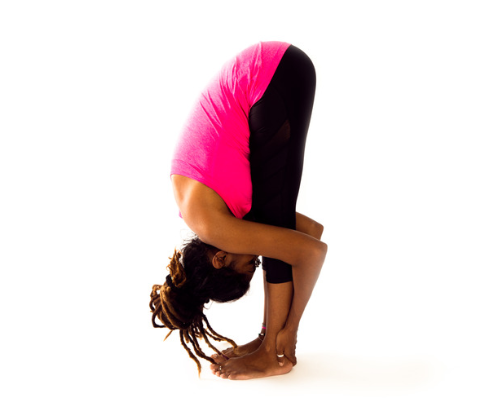
There are different types of forward bends, each with varying levels of intensity. In bending forward towards our thighs, we are flexing the spine. This both stretches and strengthens the muscles along the spine, shoulder, pelvic girdles, and legs. Abdominal muscles are also strengthened.
• Place your buttocks firmly on the floor
• Extend your legs outwards.
• Lean forward, head facing down.
• Try to reach your feet, with your hands.
• Hold for 5-10 breaths, repeat as needed.
2. Child pose
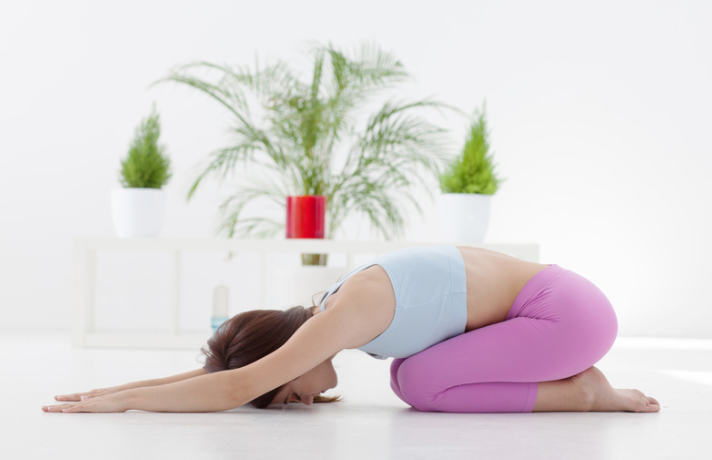
The child pose helps elongate your back and is a destresser.
• Stretch your arms out in front of you as you are sitting on all fours.
• Sit back and make sure your butt muscles are resting just above your heels.
• Hold for 5-10 breaths. Repeat.
3. Downward-facing dog
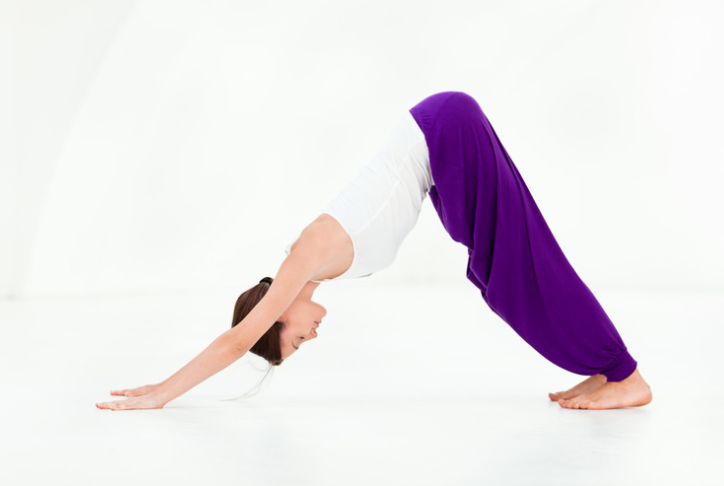
This a great total body stretch that targets the lower muscles that help form your lower back, providing needed support for your spine.
• To do this, start on your hands and knees.
• Make sure your hands are only slightly in front of your shoulders.
• Then press back and raise your knees, away from the floor.
• Focus on lifting that tailbone of yours towards the ceiling.
• For a hamstring stretch, softly push your heels towards the floor.
• Hold this position for 5-10 breaths.
• Repeat 5-7 times
4. Cat and cow pose
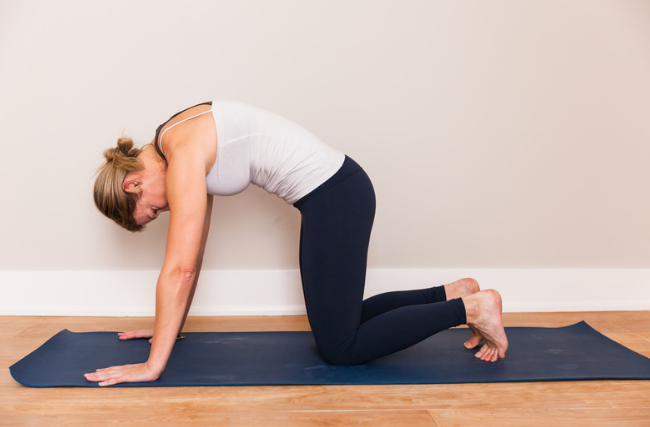
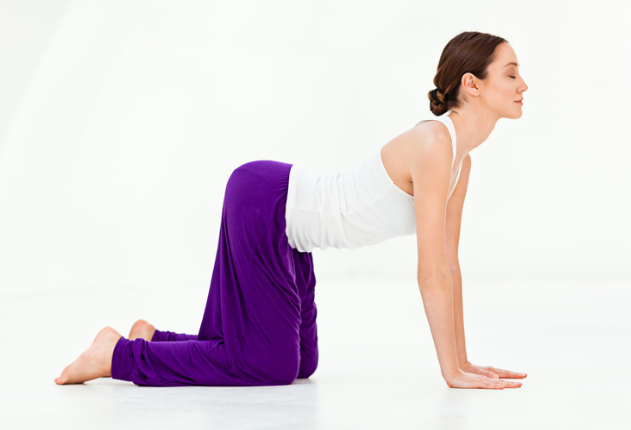
This helps loosen back muscles and is ideal for relieving you of lower back pain.
• Start by going on all fours.
• Slowly press your spine upwards as you move into the cat pose.
• Make sure your back is arched.
• Hold each position for 10 seconds.
• Make sure your shoulder blades are pressed back and your head is lifted.
• Move back and forth between these poses.
• Repeat 10 times.
5. Upward-facing dog
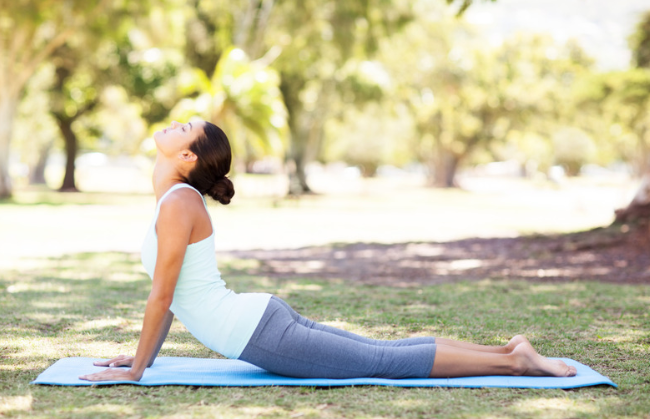
This opens your chest, stretches your abdominal muscles and also engages your back.
• Lie flat on the floor, palms facing down – near the middle of your ribs.
• Press the top of your feet into the floor, while drawing your legs together. While doing this, lift your chest off the floor. Make sure you use back strength and not your hands
• Keep legs extended.
• Hold for 5-10 breaths and repeat.
6. Bird dog
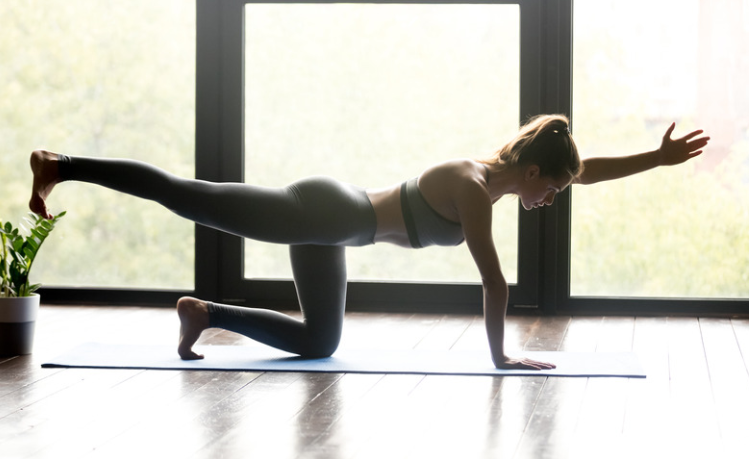
This is a simple core exercise that improves stability, encourages a neutral spine, and relieves low back pain. It strengthens your core, hips, and back muscles. It also promotes proper posture and increases range of motion.
• Begin on all fours in the tabletop position. Place your knees under your hips and your hands under your shoulders. Maintain a neutral spine by engaging your abdominal muscles.
• Raise your right arm and left leg, keeping your shoulders and hips parallel to the floor. Lengthen the back of your neck and tuck your chin into your chest to gaze down at the floor.
• Hold this position for a few seconds, then lower back down to the starting position.
• Raise your left arm and right leg, holding this position for a few seconds. Return to the starting position. This is one round.
• Do 2-3 sets of 8-15 repetitions.
7. Knee to chest

Here’s a way to get your legs pumping as a treatment for low back pain symptoms. Follow these directions to perform a safe knee-to-chest workout.
• Lie on your back. Put your feet flat on the floor and bend your knees.
• Draw your right knee up to your chest. Keep the left foot flat against the floor.
• Hold for 15-30 seconds. Meanwhile, be sure to keep your lower back flat on the floor.
• Next, lower your right knee. Repeat the routine with the left leg.
For each leg, perform knee-to-chest five to ten times.
There are many different kinds of stretching and exercises that we can do to help build up cores and back muscles. Choose the ones that match your condition. If you are not sure about what to do, please contact us for professional advice.
Here’s a video explaining what muslces plays a big part in our lower back health and how to stretch those muscles properly.
Don’t just sit there
Don’t sit in the same position for long periods. Make sure you take any opportunity you can to move your body by setting alarms to take breaks.
When you’re moving, different muscle groups share the work of keeping your head, neck, back and the rest of your body supported, rather than continually overloading the same muscles.
Maintain good posture
The quality of your posture has a dramatic impact on the health of your lower back.
• Being mindful of how you position your body.
• Creating an ergonomic workspace which includes an ergonomic chair.
• Wearing comfortable clothing.
• Using devices which provide support to the lumbar region of your back.
• Incorporating more movement into your day.
Use heat therapy
If you are already experiencing lower back pain while in lockdown, try using heat therapy. Applying heat to your lower back will relax your muscles and relieve inflammation. If you do need more advice, feel free to contact us during lockdown.
Allied health treatment options for low back pain?
Acupuncture, physiotherapy and therapeutic massage can improve lower back pain and the mobiliy, strength and flexibility of our body. We provide online consultation and treatment during lockdown to guide you on how to choose trigger points, acupoints, exercises, diet and many more to relieve your pain immediately. If you feel like talking to one of our professionals, please don’t hesitate to contact us.
Lockdown could be longer than what we expected. Let’s stay positive and well and get through this together. We are here for you!
Learn more:
Follow us at

